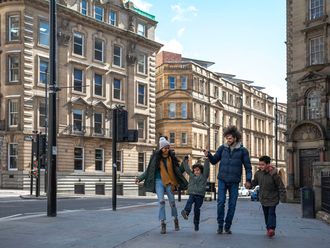
It’s 1am and as the minibus transporting us from the airport approaches the small port of Bodrum on the southwest coast of Turkey, bright green lasers sweep across the harbour, almost as if they are welcoming us.
“That’s Halikarnas, the world’s largest open-air nightclub,” the driver says. Egos deflated, we watch the lasers light up the 15th Century St Peter’s Castle, casting a spell across the town that’s historical as well as a burgeoning playground for the world’s jet set.
The driver goes on to tell us that rock star Mick Jagger’s daughter, Jade Jagger, is a regular there, and even has her own restaurant, The Secret Garden, at the Halikarnas. In its more than 30 years as a club, the Halikarnas has seen A-listers such as the late Princess Margaret, actor Michael Caine and the Rothschilds, as well as Jade’s dad Mick.
Sadly we couldn’t go straight there to join the elite in the VIP booths or strut our stuff on the amphitheatre-style dance floors; we went straight to our hotel, the Marmara Bodrum.
Sedef Baran, Astas Holdings’ marketing coordinator, is on hand to welcome us. She and the staff of the beautiful boutique hotel on top of the hill overlooking the harbour give us a taste of Turkish hospitality, treating us like long-lost friends.
In Bodrum, small is beautiful. There is nothing showy about this contemporary hotel, which combines traditional architecture with flourishes of cutting-edge design.
The warmth of the Turkish people is evident in little touches – guests are welcome to write graffiti messages across a long corridor to the right of the lobby. A quick scan turns up both local and international luminaries among the scores of visitors who’ve penned a few verses or sketched a piece of art on the white walls.
The rooms all have fantastic views across the harbour. Standing on my balcony, I shiver a little as the breeze turns cool. It smells like rain.
The following morning I realise my instinct was correct when I wake up to a steady pitter-patter of raindrops.
Though we are here to check out Astas Holdings’ new billion-Euro development, The Residences, Sedef decides to give us the grand tour of her favourite town beforehand. She even gets hold of a learned professor of history to give us some pointers about Bodrum’s past before the tour.
While we’d learnt about the many contemporary stars who visit Bodrum – Beyoncé, Tom Hanks, Pamela Anderson, Uma Thurman, Dustin Hoffman, Naomi Campbell, Sting, Nicole Kidman and Norah Jones, to name just a few – from our driver the previous night, the professor’s info proved that Bodrum had been a magnet for stars in the past too.
According to the professor, in its more than 3,000-year life cycle, Bodrum, then known as Halicarnassus, has seen more exalted historic personalities than any other resort. Apparently Antony and Cleopatra slept in Bodrum. Alexander the Great, who conquered the city in 334BC, was so captivated by its coves and beaches that he broke off his military campaign to idle away hours exploring the numerous nooks and crannies along the coast and white sand beaches before pushing on.
The greatest of Greek poets and the author of The Iliad and The Odyssey, Homer, is said to have written, ‘Halicarnassus is the land of eternal blue.’ Perhaps he was taking a break from writing his epics.
To top off the list of ancient who’s who, it turns out that Herodotus, the Greek historian known to the world as The Father of History, was born in Bodrum in the 4th Century BC. Bodrum really is steeped in history.
The ancient Bodrum Amphitheatre is close to the town centre on the road to Gumbet and overlooks the tranquil harbour, castle, and azure sea. The theatre stones were assembled back in the 4th Century BC. In those days apparently there was room for 13,000 spectators. Today, the outdoor theatre is a venue for concerts and other entertainment. Its modern-day capacity after being rebuilt is 4,000 people – far smaller than in ancient times.
Bodrum is also famous for being the site of one of the Seven Wonders of the Ancient World. The ruin of the famous Tomb of Mausolus, or Mausoleum, is open to the public, but after two millennium of earthquakes, wars, storms, and being salvaged for parts to build other structures, there isn’t much left.
Parts of the Myndos Gate that faced the ancient city of Myndos and was the scene of one of the bloodiest battles between Alexander the Great and the Persians of Halicarnassus still remain.
The impressive 15th Century castle of St Peter, built by the Knights of St John of Rhodes in 1406, is at the centre of Bodrum’s two crescent-shaped harbours. The castle has a tempestuous history and is full of remarkable stories and artefacts.
It also houses the famous Museum of Underwater Archaeology, with all kinds of treasure (coins, glassware, gold, weapons) found in shipwrecks around the area including the oldest shipwreck ever discovered (14th Century BC). Some rooms such as the English Tower are decorated in the style of the medieval period.
After all those historical detours, it is time to check out The Residences. The site of this exciting new development is Cennet Koyu, which means Paradise Bay. The name has withstood for centuries, and it’s easy to see why: it truly looks like paradise.
The mild weather we experience is said to be a constant. The cool breeze carries the smell of pine and olive. The crystal clear waters set off the white sandy beach and just a few metres away are lush green forests.
The view from the property reveals a stunning landscape – beautiful pine forests and ancient olive groves lining idyllic turquoise bays, and a permanently balmy climate.
Bodrum has been given many favourable nicknames in its time, including the Monte Carlo of the Aegean and the latter-day Saint- Tropez. But its aesthetic is all its own.
Looking at the breathtaking setting, there is no question why Vedat Aşci, chairman of the board of directors for Astaş Holding, wanted to establish the luxury hotel and residence project here.
Located on a 60-hectare waterfront site, the development features a 2km stretch of shoreline with three private bays. The Residences at Mandarin Oriental, Bodrum, includes 98 villas and 116 residences, six restaurants, including al fresco waterside dining, a snazzy lobby lounge, poolside bar and a signature Mandarin Oriental Cake Shop along with a spa.
Designed by leading architects, all the villas and residences are built on a series of levels nestled into the development’s perfectly landscaped hillside, surrounded by lush forest and ocean views.
The villas feature infinity pools and stunning interior designs. When complete, the Mandarin Oriental, Bodrum, hotel will offer 82 exclusive guest rooms and 20 suites with views of the Aegean Sea.
After a grand tour of the property, we are taken for a cruise on Vedat’s superyacht around the bay.
The property looks even more stunning when viewed from the sea, and the weather is perfect for a lazy afternoon in the mild sun. Idle thoughts float around my head – if this is not paradise, then what could it be? A state of mind, probably.
For Vedat, it is something more. At €600 million (more than Dh3 billion), the entire development is a tad above his usual deals in the textile industry where he first made his fortune.
But the Istanbul-based tycoon is relaxed and happy. Approximately 50 per cent of the residences have been sold. Prices range from €1.2m to €6m, and handovers began earlier this year.
“Customers tend to be Turkish, European and from the CIS,” says Vedat. The Middle East also figures on the list, though so far they’ve had only 15 customers from the Gulf.
This was because until July 2012, buyers from the Gulf were unable to invest in Turkish real estate due to the country’s reciprocity law. Now that this rule no longer applies, Vedat expects more investors from the region. “The Turkish economy has been very strong in the past 10 years,” says Vedat. “A lot of Arabic people are coming to Turkey to holiday, to buy and for investments.”
According to Turkey’s Ministry of Culture and Tourism, the number of visitors to the country from the UAE and Saudi Arabia increased by 82.84 per cent and 96.15 per cent last year, respectively.
After all that hard business talk, it was time for some lazing around, and Bodrum is perfect for just that. After wandering around the pretty restaurants and cafés that line the harbour, we sit and sip a coffee while watching the traditional Turkish wooden boats known as gulets bobbing in the sea.
Later, while going through the winding alleyways of the outdoor market, we try out some of Turkey’s famous leather sandals. A pipe-smoking local tells us that Ali Guven’s shop is just across the courtyard.
Ali Guven? The old man’s wizened eyes grow large when he realises that we don’t know Bodrum’s famous sandal maker. When we meet the white-moustached yet youthful-looking Ali, he tells us he’s been making sandals since 1966. The 68-year-old is surrounded by piles of cardboard cut-outs of measurements of feet and semi-finished sandals in his small workshop.
Ali makes non-perspirant sandals consisting of a naturally treated leather sole secured to the ankles by strips of leather. He’s made many for the rich and famous such as Mick Jagger and his family, Bette Midler and many famous Turkish artists.
Despite all that he still remains humble, stuck to his small shop, almost always bent over his work. He’s not interested in making money, but he would like to see a museum for his work, he says. His sandals cost around 100 Turkish lira (around Dh160), and are a steal at the price.
All too soon, it’s time to leave, and the withdrawal symptoms hit us even before we reach the airport. The thought lingers: If we could chance upon a couple of million Euros, we could own a piece of this paradise…











